Travel to Gatorland, south of Orlando, Florida and find a bird photographer’s paradise.
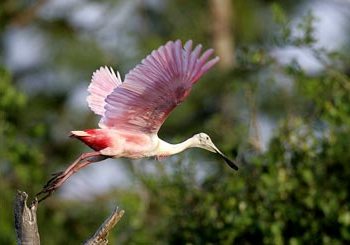
Copyright © Andy Long
A temporary landing spot is one time to keep focused on the subject–here a Roseate Spoonbill. Be patient and you’ll get the desired shot before moving on to the next subject.
What started in 1949 as a roadside attraction enabling visitors to see alligators “up close and personal” has morphed into a large alligator entertainment center. For serious bird photographers, Gatorland, south of Orlando, Florida, has become a must-visit spot. In the early 1990s, birds found the swamp area to their liking and built nests in order to raise their young. Today, throughout the nesting season (from January until August and sometimes September) more than 1,000 nests can be counted for activity. At peak times more than 100 nests are active.
Like many rookeries, the one at Gatorland features a wide variety of residents. A mid-April visit presented nest activity of Great, Cattle, and Snowy Egrets; Wood Storks; Roseate Spoonbills; Bitterns; Tricolored and Little Blue Heron. Also present were Green Heron, Limpkin, Osprey, Swallow-tailed Kite, Night Heron, Anhingas, Cormorants, Red-shoulder Hawk, and a variety of songbirds nesting in the area along the boardwalk which was built for easy access, viewing, and photography of the birds.
Don’t have the large lens you think is necessary for bird photography? That isn’t a problem here as there are nests in the trees that line the lake as close as two or three feet off of the boardwalk. However, a big lens can come in handy for getting shots of the birds on the banks to the east of the boardwalk or for getting tight shots of birds that are farther away.
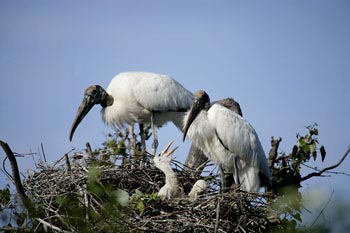
Copyright © Andy Long
Accessible Wood Stork nests make for some rare opportunities.
Photography at the rookery is a two-part adventure. During the morning hours, the area to the west of the primarily north/south boardwalk is bathed in light. The birds are fairly close in the section with the most activity, and a 70-200mm or 100-400mm lens is all that’s necessary. Also, in the morning a walk to the back side of the east section offers great views and shots of nesting wood storks. In contrast, late afternoon and evening are the best times for seeking out flight shots as the birds go to and from their nests on the east side of the boardwalk. Late afternoon is also the time when most of the roseate spoonbills head into the area. (Trying to get shots of these birds on the nest is almost impossible as they situate their nests deep in the denser areas.)
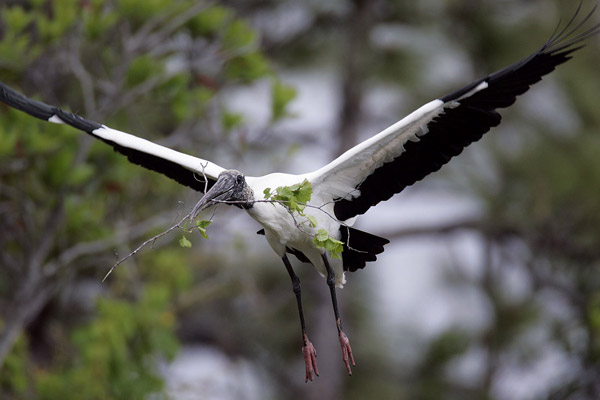
Copyright © Andy Long
Late afternoon is a good time for flight shots and I happened to catch this Wood Stork taking a twig to its nest.
A photographer’s pass is available for purchase by photographers wanting to take advantage of all the marsh and rookery has to offer. A full-day pass grants the holder early access to the rookery as well as an opportunity to stay late. (While nest activity goes from January through August, the extended hours are available only from February through the end of July.) The best way to use a full-day photo pass is to go in the afternoon and stay late and then arrive early for the morning session. Morning access begins at 7:30 a.m. and the late exit is usually around 7:30 p.m. Extended hours are available Wednesday through Sunday, allowing the rookery coordinator, Mike Godwin, a couple of days off. (He is the primary person who lets people in early and out late.) Although there are no extended hours on Monday and Tuesday, access is still available during normal hours of 9a.m. until 5 p.m. However, most of the photographers I encountered had purchased a seasonal photo pass, which allows unlimited access to the park and rookery. It pays for itself after only three visits as a single day pass cost $29.99 and an annual pass costs $99.99.
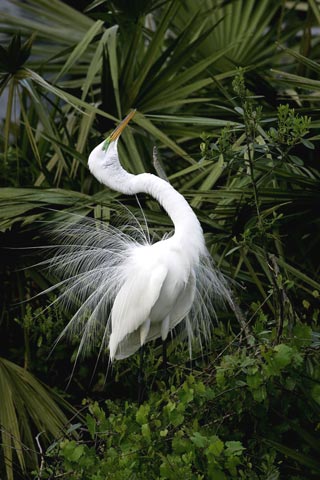
Copyright © Andy Long
A Great Egret displays its finery.
The biggest problem at Gatorland is which way to point your lens. With so much activity happening constantly in a confined area, it’s easy to miss great shots while you focus on another subject. I overheard someone exclaim that the experience was like information overload due to the great number of nests and not knowing which one to concentrate on at any given time. A good plan of attack is to concentrate on one small area to work a nest or two for a little while and then move on to another area. If you want to feature a particular topic, stick with that until you get what you want before moving on to something else. Of course, if a good subject presents itself, switch to that and go on from there. For example, I watched as a male Great Egret went into display mode and put on a show for five to ten minutes of displaying and stretching, making for some nice shots. Another time, I saw a Roseate Spoonbill perched on a branch that I knew wouldn’t be there for long, so I took advantage of the opportunity to take a shot of it taking flight (see opening article photo).
Once babies start showing up in the nests, it’s fairly common to have nestlings of various stages–from a few days old to getting ready to fledge. Offspring of different ages are often right next to each other. Some of the nests are also very close to the boardwalk. It might seem odd that birds would nest so close to a lot of people walking by all day long, but they have become accustomed to the presence of humans as visitors typically respect the birds and their privacy. However, their nests are so carefully tucked into the trees that they are difficult to photograph. Even so, in my experience, everyone with a camera on the boardwalk was trying to get shots of the babies in the two closest nests. Lighting was tough and there were only one or two gaps between branches allowing for a clear view, but because of the closeness, the nests were a popular subject.
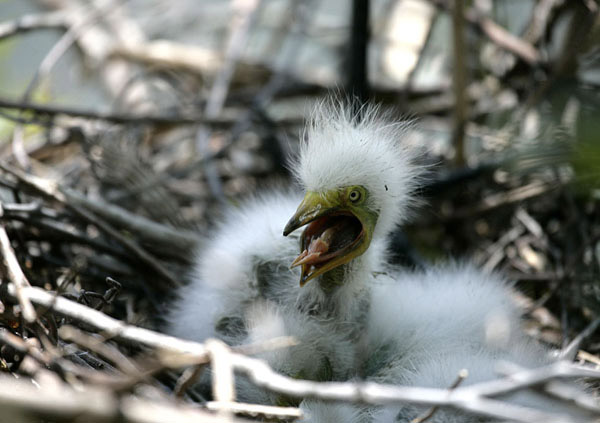
Copyright © Andy Long
Maybe this baby is saying, ” Enough with the photos, O.K.
I just can’t smile anymore!”
While most of the adult birds in the rookery keep to themselves and their nests, one dead tree is a popular spot for the Roseate Spoonbills. They aren’t the only birds to spend some time here and this sometimes provides for some good interaction shots as a spoonbill and another bird squawk and nip at each other. Another interesting sight happens each evening with the arrival of several hundred ibis that use the rookery as a nightly roosting spot. By the time visitors arrive in the morning, not one remains on any branch.
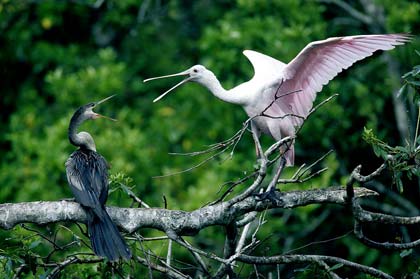
Copyright © Andy Long
Squabble taking place–I think the lady in pink will definitely win this discussion!
In Gatorland, the waters below the nests are filled with alligators and even a couple of crocodiles. They provide a bit of protection for the birds from land predators, but if a young bird falls from its nest, it will rarely survive. However, because the gators are fed regularly, it’s not unusual to see an adult bird wading in the water in search of a small fish or twig just a few feet away from what would–in the wild–be a primary predator.
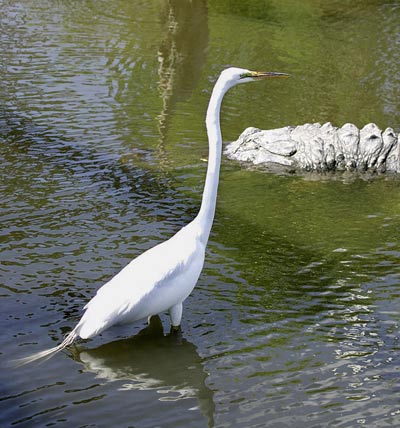
Copyright © Andy Long
Walking amongst the gators is safer than you would imagine.
Backgrounds can be a bit difficult at Gatorland. Lots of branches and foliage can obscure many nests. No matter how wide open your aperture is, you must consider the background when you’re taking shots. Luckily, the boardwalk is wide enough to accommodate many curious people and photographers. There’s even enough room for a photographer to set up a tripod without fear of passers-by bumping it as they walk past.
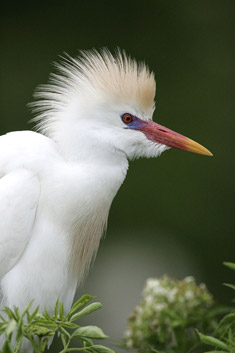
Copyright © Andy Long
Close-ups, such as this Cattle Egret, are easily obtainable no matter what kind of lens is used.
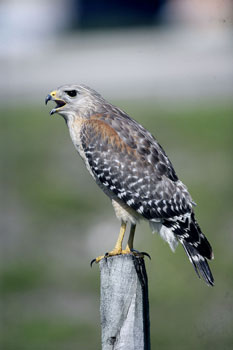
Copyright © Andy Long
A Red-shouldered Hawk surveys the area.
A single day can be sufficient to catch plenty of good photos at Gatorland. However, two days are optimal so that you can capture all subjects–from nests to flights to close-ups. Besides all of the birds in the rookery area, you’ll also find parrots, macaws and a flamingo island.
Oh yes, there are also a few alligators.
by Andy Long

Leave a Reply